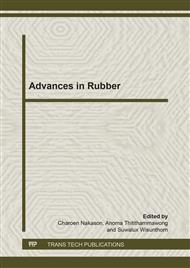p.69
p.73
p.77
p.81
p.85
p.89
p.93
p.97
p.101
The Method to Produce Light-Color Natural Rubber
Abstract:
It is known that natural rubber (NR) has a naturally occurring color, which restricts to some applications of NR, especially for producing light-colored NR products. Thus, this present work was an attempt to find the appropriate method for promoting the light color NR. First, the color substances in NR were extracted by a certain method and subjected to analysis by Thin layer chromatography (TLC). They were separated by hexane/diethyl ether (7:3 v/v). The separation was detected using 3% cupric acetate in 8% phosphoric acid (H3PO4) and heated at 180 degree C. It was found that the color extracts from NR comprise of various compounds such as carotenoids, free fatty acids, tocotrienols, oxidized proteins, etc. Developments of light color NR were carried out by the addition of enzymatic browning inhibitors, i.e., sodium metabisulphite (SMS) in latex and the employment of some chemicals, i.e., proteolytic enzyme, sodium hydroxide, to discolor the rubber. It was found that the color index of NaOH-treated rubber or saponified rubber (SP) was lightest, whereas the color of urea-treated rubber or deproteinized rubber (DP) was close to the centrifugation rubber. The treatment of SMS showed an insignificant effect on the decoloring of NR. DP and SP showed very low nitrogen content, so these may be effective methods to produce light-color NR.
Info:
Periodical:
Pages:
85-88
Citation:
Online since:
November 2013
Authors:
Keywords:
Price:
Сopyright:
© 2014 Trans Tech Publications Ltd. All Rights Reserved
Share:
Citation:


